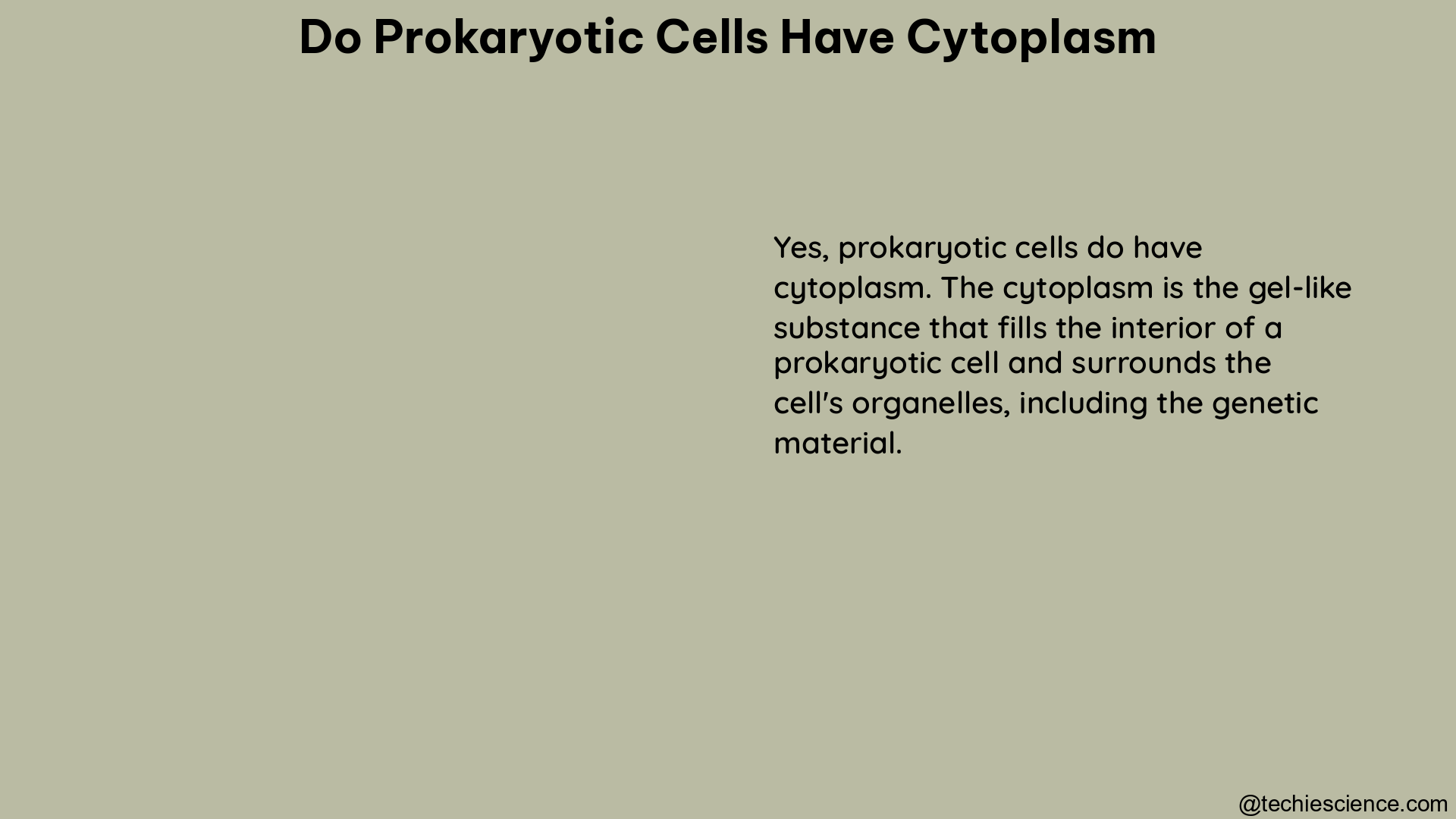Prokaryotic cells, which include bacteria and archaea, are the simplest and most abundant form of life on Earth. These single-celled organisms are characterized by the absence of a true nucleus and membrane-bound organelles, in contrast to the more complex eukaryotic cells found in plants, animals, and fungi. One of the defining features of prokaryotic cells is the presence of cytoplasm, a gel-like substance that serves as the medium for various cellular processes.
The Composition of Prokaryotic Cytoplasm
The cytoplasm of prokaryotic cells is primarily composed of water, which accounts for approximately 70-95% of the cell’s total volume. Dissolved within this aqueous medium are a variety of organic and inorganic molecules, including:
-
Proteins: These macromolecules play a crucial role in the structure, function, and regulation of the cell. Enzymes, structural proteins, and transport proteins are all found within the cytoplasm.
-
Nucleic acids: The genetic material of prokaryotes, typically in the form of a single, circular DNA molecule, is located within the cytoplasm.
-
Carbohydrates: Sugars and polysaccharides serve as energy sources and structural components within the cytoplasm.
-
Lipids: These hydrophobic molecules are involved in the formation of cellular membranes and can also serve as energy reserves.
-
Inorganic ions: Ions such as potassium, sodium, calcium, and magnesium play crucial roles in maintaining the cell’s pH, osmotic balance, and various enzymatic reactions.
The specific composition of the cytoplasm can vary depending on the species of prokaryote, its environmental conditions, and its metabolic state.
The Functions of Prokaryotic Cytoplasm

The cytoplasm of prokaryotic cells serves several essential functions:
-
Cellular organization: The cytoplasm provides a medium for the organization and distribution of cellular components, such as the genetic material, ribosomes, and various inclusions.
-
Metabolic processes: Many of the cell’s metabolic reactions, including energy production, biosynthesis, and waste disposal, take place within the cytoplasm.
-
Cellular transport: The cytoplasm facilitates the movement of molecules and organelles within the cell, as well as the transport of materials across the cell membrane.
-
Cellular signaling: The cytoplasm serves as a platform for various signaling pathways and regulatory mechanisms that coordinate the cell’s responses to environmental stimuli.
-
Compartmentalization: While prokaryotic cells lack membrane-bound organelles, the cytoplasm can contain specialized inclusions, such as storage granules, gas vesicles, and carboxysomes, which help to compartmentalize specific cellular functions.
Differences between Prokaryotic and Eukaryotic Cytoplasm
The cytoplasm of prokaryotic cells differs from that of eukaryotic cells in several key ways:
-
Complexity: Eukaryotic cells have a more complex and compartmentalized cytoplasm, with various membrane-bound organelles (e.g., mitochondria, endoplasmic reticulum, Golgi apparatus) that perform specialized functions. Prokaryotic cells lack these membrane-bound organelles.
-
Genetic material: In prokaryotes, the genetic material is typically a single, circular DNA molecule located within the cytoplasm, while eukaryotic cells have a true nucleus containing multiple, linear chromosomes.
-
Size: Prokaryotic cells are generally smaller in size compared to eukaryotic cells, with diameters ranging from 0.1 to 5.0 micrometers (μm), while eukaryotic cells can range from 10 to 100 times larger.
-
Cytoskeleton: Eukaryotic cells have a more complex cytoskeleton composed of microtubules, actin filaments, and intermediate filaments, which provide structural support and facilitate intracellular transport. Prokaryotic cells have a simpler cytoskeleton or lack one entirely.
-
Inclusions: Prokaryotic cells often contain specialized inclusions within the cytoplasm, such as storage granules, gas vesicles, and carboxysomes, which are not found in eukaryotic cells.
Techniques for Studying Prokaryotic Cytoplasm
Researchers employ various techniques to study the structure and function of prokaryotic cytoplasm, including:
-
Electron microscopy: Transmission electron microscopy (TEM) and scanning electron microscopy (SEM) allow for high-resolution imaging of the cytoplasmic structure and the identification of cellular inclusions.
-
Biochemical analysis: Techniques such as protein purification, enzyme assays, and spectroscopic analysis can provide insights into the chemical composition and metabolic activities within the cytoplasm.
-
Genetic and molecular biology techniques: Genetic manipulation, gene expression analysis, and the use of fluorescent reporter proteins can help elucidate the role of specific cytoplasmic components and their involvement in cellular processes.
-
Bioinformatics: Computational analysis of genomic and proteomic data can provide valuable information about the genes and proteins involved in the organization and function of the prokaryotic cytoplasm.
-
Microscopy techniques: Advanced microscopy methods, such as fluorescence microscopy and super-resolution microscopy, enable the visualization and tracking of specific cytoplasmic structures and molecules in living cells.
Conclusion
In summary, prokaryotic cells do indeed possess a cytoplasm, a gel-like substance that serves as the medium for various cellular processes. The cytoplasm of prokaryotes is less complex compared to the cytoplasm of eukaryotic cells, but it plays a crucial role in the organization, metabolism, and signaling of these simple yet ubiquitous life forms. Understanding the structure and function of the prokaryotic cytoplasm is essential for advancing our knowledge of microbiology and the fundamental mechanisms of life.
References:
- Alberts, B., Johnson, A., Lewis, J., Raff, M., Roberts, K., & Walter, P. (2002). Molecular Biology of the Cell. Garland Science.
- Madigan, M. T., Martinko, J. M., Bender, K. S., Buckley, D. H., & Stahl, D. A. (2015). Brock Biology of Microorganisms (14th ed.). Pearson.
- Neidhardt, F. C. (1996). Escherichia coli and Salmonella: Cellular and Molecular Biology. ASM Press.
- Tortora, G. J., Funke, B. R., & Case, C. L. (2018). Microbiology: An Introduction (13th ed.). Pearson.
- Whitman, W. B., Coleman, D. C., & Wiebe, W. J. (1998). Prokaryotes: the unseen majority. Proceedings of the National Academy of Sciences, 95(12), 6578-6583.
Hi..I am Tanu Rapria, I have completed my Master’s in Biotechnology. I always like to explore new areas in the field of Biotechnology.
Apart from this, I like to read, travel and photography.